
Firstly, let’s look at the main features and components that make a good all-round camping stove.
What to look for in a camping stove
Weight
As with any equipment, effectiveness must be weighed against weight concerns. Stove systems are at the heavier end of the range, although more minimalist canister stoves, alcohol, or solid-fuel tablet stoves can provide a lightweight camp cooking alternative.
Packed size
Similarly, the size of your selected camping stove should be assessed with your other equipment. If you want to use your camping stove on multi-day journeys, be sure the burner, pans, and fuel all fit inside a backpacking backpack. If you’re only cooking for one person on a backpacking trip, you can keep things small. If you’re going hillwalking for the day, you might want to consider a bigger choice, but you’ll welcome the extra space in your daypack for layers, a map and compass, food, and water.
Stability
Of course, camp cooking can be risky, particularly during the dry season. It’s also frustrating to make supper just to lose everything due to an unsteady setup. Stoves, such as remote canister stoves, are the most stable due to their low length and proximity to the ground. Some taller types, such as integrated stove systems, have stabilizing post supports, however, these are frequently offered separately. They also add weight to your entire system.
Boil time
Some campers like waiting for their water to boil so they can rehydrate their meal. Others desire instant pleasure while waiting for their coffee in the morning. It is a question of personal choice. However, if you want a speedy and efficient boil time, search for a burner power output wattage ranging from 2,000 to 4,000
Burner head
The diameter of your burner head impacts the success of your camping meals. Gas stoves with smaller burner heads can create burn zones, or hot areas, on cooking pans. Others are wider to reduce this, but do not cook the contents of tall pots as rapidly. A modest diameter should enough for boiling water, but for cooking solid items, a broader head may be required to prevent your noodles from crisping to the bottom of the pot.
Flame regulation
A flame regulator will be useful for any camp cooking that is not limited to boiling water. The good news is that most modern camp stoves include a control valve that allows you to alter the intensity of the flame.
Wind Protection
Almost every camper has experienced the way winds and gusts can pick up in high areas. So, you’ll need to invest in wind protection for your camping stove or risk losing its efficiency. Windshields improve efficiency by protecting against the weather and acting as a heat reflector. These can be incorporated or constructed from thin aluminum sheets.
220g Butane Gas Stove for Outdoor Campsite Cooking
Description
- The burner head of this remote gas stove is made of a specific metal alloy that allows it to work as an infrared stove.
- Its innovative circular windshield design successfully withstands 5-grade wind power.
- This windproof remote camping stove provides very firm support for larger and heavier camping gear, and it can take up to 10kg of weight during cooking, making it the finest choice for family camping.
- To make it easier to ignite this camping stove leg, we incorporated a piezo ignition.
- The support legs move to the side to fold to a tiny size, and the bottom bracket may also be folded freely to decrease packing space.
- High power provides the highest heat efficiency, resulting in significant fuel savings.
- This remote camping gas stove is suitable for family camping, fishing, and hunting.
Portable Remote Gas Stove for Outdoor Camping
Description
- This remote stove includes the gas remote hose. It has low gravity and may be utilized on uneven floors.
- It is built of a high-quality stainless-steel material. It is highly durable and may be used for an extended period of time.
- The burner top has a two-layer structure, with the top layer composed of a rare metal with an infrared function. The foundation layer can maintain equal output throughout the cooking process.
- This high-performance gas burner produces 2900W and takes just 3’35” to boil 1L of water. This portable gas burner is sturdy and weighs around 305 grams. We can fold it to a compact size, making your backpack more portable.
Outdoor Camping Remote Gas Stove with Pressure Regulator Adjustable Valve
- The submerged burner head provides excellent wind resistance, while the irregularly shaped burner top delivers a concentrated flame during cooking.
- This remote gas stove has a pressure regulator valve that allows it to maintain a steady output even at low temperatures.
- The hiking stove brackets join together with a solid center base to provide highly steady cooking, and its support range allows you to place various large camping cookware on it.
- The air intake is positioned at the bottom of the gas tube, which makes the entire stove seem nice.
- The gas remote design makes this backpacking stove very easy to use; it can function with large pots and withstand heavy loads, so it’s also suitable for group usage.
ODM service
Looking for reliable camping stove supplier? At Deermaple, we specialize in ODM service, offering high-quality, innovative camping stoves tailored to your needs.
If you are interested in camping stove wholesale , please contact us.












